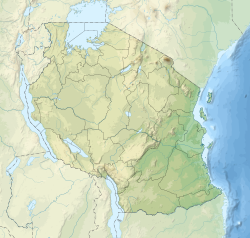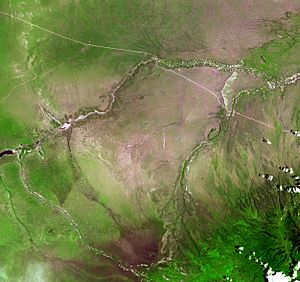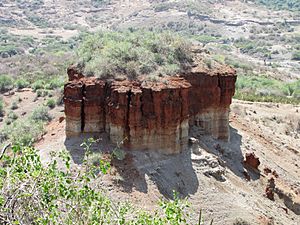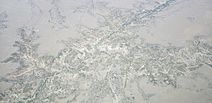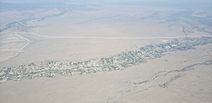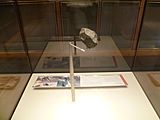Olduvai Gorge facts for kids
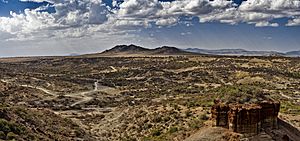
View of Olduvai Gorge with the Naibor Soit hills visible in the distance.
|
|
| Location | Ngorongoro District, Arusha Region, |
|---|---|
| Region | Eastern Africa |
| Coordinates | 2°59′37″S 35°21′04″E / 2.993613°S 35.35115°E |
| Type | Archaeological |
| Length | 48km |
| Site notes | |
| Excavation dates | 1913, 1935, 1941, 1953, 1955, 1958 & 1960 |
| Archaeologists | Wilhelm Kattwinkel, Louis Leakey, Mary Leakey, Percy Edward Kent & Jonathan Leakey |
| Condition | Excavated |
| Ownership | Tanzanian Government |
| Management | Antiquities Division, Ministry of Natural Resources and Tourism |
| Public access | Yes |
|
Invalid designation
|
|
| Official name | Oldupai Gorge |
| Type | Pre-historic |
The Olduvai Gorge (also called Oldupai Gorge) in Tanzania is one of the most important places in the world for studying early humans. Many discoveries here have helped us understand how humans evolved.
This deep valley is part of the Great Rift Valley in East Africa. It is about 48 kilometers (30 miles) long. You can find it in the eastern Serengeti Plains, inside the Ngorongoro Conservation Area. It's about 45 kilometers (28 miles) from Laetoli, another key site for early human history.
The famous team of Mary and Louis Leakey, who were paleoanthropologists and archaeologists, started digging and researching at Olduvai Gorge. Their work led to huge breakthroughs in our knowledge about human history. This site is now a National Historic Site of Tanzania.
The gorge gets its name from the Maasai word oldupai. This word means "the place of the wild sisal." The East African wild sisal plant (Sansevieria ehrenbergii) grows everywhere in the gorge area. The gorge formed from about 90 meters (300 feet) of erosion. This erosion cut into the sediments of an ancient lake bed from the Pleistocene era.
A smaller valley, coming from Lemagrut Mountain, joins the main gorge. This side valley follows the edge of a prehistoric lake. This area is full of fossils and sites where early human ancestors lived. Volcanic ash from nearby volcanoes like Olmoti and Kerimasi helped preserve these fossils over millions of years.
Olduvai Gorge is important because it shows how early human ancestors, called hominins, became more developed and social. We see this especially in how they made and used stone tools. Before tools, early humans were scavenging (eating what other animals left behind) and hunting. We know this because some bones have gnaw marks from animals before cut marks from tools. The types of food they ate, like meat and plants, also changed.
When early hominins started gathering tools and animal remains in one place, it showed they were developing social interaction and working together. All these signs point to early humans becoming smarter and more capable.
Homo habilis, possibly the first early human species, lived at Olduvai Gorge around 1.9 million years ago (mya). Then came Paranthropus boisei, another human ancestor, about 1.8 mya. After that, Homo erectus appeared around 1.2 mya. Finally, Homo sapiens (modern humans), who first appeared about 300,000 years ago, are thought to have lived in the gorge about 17,000 years ago.
Contents
Discovering Olduvai's Past
Early Finds and Explorers
In 1911, a German doctor and archaeologist named Wilhelm Kattwinkel visited Olduvai Gorge. He was traveling in German East Africa to study sleeping sickness. There, he found many fossil bones of an extinct three-toed horse.
Inspired by Kattwinkel's find, a German geologist named Hans Reck led a team to Olduvai in 1913. He discovered human ancestor remains that were later dated to 17,000 years ago. More expeditions were planned, but World War I stopped them.
After the war, Louis Leakey visited Reck in Berlin and saw the Olduvai fossils. Louis Leakey became sure that Olduvai Gorge held ancient stone tools. He thought the layers of earth were similar in age to another site in Kenya. In 1931, Reck and paleontologist Donald McInnes joined Louis Leakey's expedition. Soon after they arrived, Louis found several hand axes near their camp.
Mary Leakey first visited the area in 1935, joining Louis and Percy Edward Kent. The Leakeys made more visits in 1941, 1953, 1955, and 1957.
Louis and Mary Leakey are famous for most of the excavations and discoveries of human ancestor fossils at Olduvai Gorge. In July 1959, at a site called FLK, Mary Leakey found the skull of Paranthropus boisei. This site was named after Frida Leakey, who first found it, and "K" for korongo, the Swahili language word for gully.
Besides many animal remains, the Leakeys also found stone tools that Mary classified as Oldowan. In May 1960, at another site, the Leakeys' son Jonathan found a mandible (lower jawbone). This jawbone turned out to be the first example of Homo habilis.
Understanding the Earth and Finds
How Geologists Studied the Gorge
Hans Reck was the first geologist to try and understand the layers of rock in the gorge. But much of what we know today comes from the work of geologist Richard Hay. Hay spent twelve years studying the geology at Olduvai, often working with Mary Leakey. He created a detailed picture of the area's geological history. Hay's important book, The Geology of the Olduvai Gorge, was published in 1976.
Reck first identified five main layers of rock, called Beds I through V. Bed I was the oldest and lowest. Hay and other geologists have used Reck's original plan, adding more details and corrections. This has helped them understand the gorge's history even better. For example, Reck's Bed IV was later split into Bed IV and the Masek Beds. Bed V was renamed the Ndutu Bed and the Naisiuiu Bed.
Layers of the Gorge
The layers of rock in the gorge are up to 90 meters (300 feet) thick. At the very bottom is a hard volcanic rock layer called the Naabi ignimbrite. Above this are layers of lava flows from Olmoti and another southern source. The oldest fossils found on this surface are about 1.89 million years old. Stone tools have been dated to 1.7 million years ago using a method called K-Ar dating. Scientists also used other dating methods like fission track dating and paleomagnetism for the rock layers. For bones, they used amino acid dating and Carbon-14 dating. Human ancestor fossils and stone tools are found throughout all the visible layers in the gorge.
Bed I: The Oldest Layer
Bed I is 20–46 meters (65–150 feet) thick. It contains sediments from the Lower Pleistocene era. These layers are made of Olmoti volcanic ash and lake sediment claystone. Four important early human living sites are found in Bed I. These include the FLK and FLK North-North sites, plus DK and FLK North. The DK site has what Mary Leakey believes is a stone circle, along with many tools and fossil bones. These finds range in age from 1.75 to 1.9 million years ago.
Bed II: More Discoveries
Bed II is 21–35 meters (70–115 feet) thick. It consists of clay and sandstone from the Olduvai Lake and streams. At the MNK site, many manuports (natural objects carried by humans) are found. There is also a chert nodule quarry with over 14,000 pieces. These include gneiss and lava anvils and hammerstones. Hand axes were found at the EF-HR and TK sites. The BK site contained a young Australopithecus boisei tooth.
Bed III: Changing Waters
The red-colored Bed III is 6–10 meters (20–33 feet) thick. It is made of clays, sandstones, and conglomerates. This shows that the lake depth changed a lot. Few fossils and only scattered stone tools are found here. This suggests that early humans were not present in large numbers during this time.
Bed IV: More Tools
Bed IV is different from Bed II in the eastern part of the gorge. It is 5–8 meters (16–26 feet) thick. It is made of clays and stream-deposited sandstones and conglomerates. Four clear levels with tools are found here. These include 500 handaxes and cleavers at the HK site. phonolite handaxes and an elephant bone handaxe were found at the HEB site. The WK site contained a Homo erectus pelvis and thigh bone.
Masek Beds: Volcanic Ash
The Masek Beds are made of two layers of wind-blown ash from Kerimasi volcano. Many quartzite handaxes were found in this layer at the FLK site. Dunes formed after ash from the Oldonyo Lengai volcano settled. These make up the upper part of the Ndutu Beds, but they have few fossils. Oldonyo Lengai ash also forms the Naisiusiu Beds.
Human Ancestor Fossils Found
A few remains of Australopithecus boisei, including a skull, a thigh bone piece, and several teeth, were found throughout Beds I and II. This dates them to between 1.1 and 2 million years ago. More common remains of Homo habilis were found in Bed I and the lower part of Bed II. This means they lived at the same time as Australopithecus boisei. Homo erectus remains were found in the upper parts of Bed II. This means they lived at the same time as Australopithecus boisei, but not Homo habilis.
Stone Tools and Their Makers
Louis Leakey first described the Oldowan stone tool industry in 1951. The Leakeys found that choppers were the most common stone tool at the gorge. They made up over half of all tools found. They identified 11 Oldowan sites in the gorge: 9 in Bed I and 2 in Bed II.
They also identified a later, more varied tool kit called the Developed Oldowan. This was found in Beds II, III, and IV. These tools were smaller and mostly made from chert instead of quartzite. Most of these tools were spheroids (round stones) and sub-spheroids, followed by choppers.
Besides the chert quarry in Bed II, the Leakeys found where the main rocks for the tools came from. Most of the quartzite came from the Naibor Soit Inselberg (an isolated hill) just north of the gorge. The phonolite came from the Engelosen volcano, 5 kilometers (3 miles) to the north. The gneiss came from the Kelogi inselberg, 9 kilometers (5.6 miles) to the southwest.
The first human ancestor species found by the Leakeys was Zinjanthropus boisei, later renamed Australopithecus boisei (and still debated as Paranthropus boisei). This species had a sagittal crest (a ridge on top of the skull) and large molars (back teeth). These features suggest they did a lot of heavy chewing. This means their diet likely included tough plant material. This could have been tubers, nuts, seeds, and possibly large amounts of grasses and sedges.
In the 1960s, the Leakeys found different fossils. These skulls did not have a sagittal crest, and their braincase (the part of the skull holding the brain) was much rounder. This suggested it was not an australopithecine. The larger braincase meant a bigger brain than Australopithecus boisei. These important differences pointed to a new species, which was named Homo habilis. Its larger brain and smaller teeth suggested that Homo habilis was likely the toolmaker.
The oldest tools at Olduvai are called Oldowan tools. They are found in the lowest layers and are pebbles chipped on one edge. Above these layers, and later in time, are the true hand-axe industries, called the Chellean and the Acheulean. Even higher (and later) are Levallois artifacts, and finally the Stillbay tools. Oldowan tools are often called "pebble tools." This is because the stones chosen by the toolmakers already looked like the final tool. Mary Leakey sorted Oldowan tools by how they were used. Her work helps us understand how stone tool-making changed over time. It also helps figure out which human ancestors were responsible for these changes.
We are not completely sure which human ancestor species first made Oldowan tools. Tool culture has also been linked to Australopithecus garhi, a species before Homo. The growth of tool use is connected to early species like Homo habilis and Homo ergaster. Around 1.7 million years ago, early Homo erectus seemed to take over Oldowan technology and improved it into the Acheulean industry.
Oldowan tools are found in Beds I–IV at Olduvai Gorge. Bed I, dated 1.85 to 1.7 million years ago, has Oldowan tools and fossils of Paranthropus boisei and Homo habilis. Bed II, from 1.7 to 1.2 million years ago, also has these. H. habilis was replaced by Homo erectus around 1.6 million years ago, but P. boisei continued to exist. Oldowan tools are found up to Bed IV, dating from 800,000 to 600,000 years ago.
A big change happened between Beds I and II, around 1.5 million years ago. The size of stone flakes increased. Tools with two sharpened edges (bifacial) became more common and longer. Also, there were more signs of tools being used to hit other objects. This suggests that after this time, human ancestors used tools more often. They also became better at making tools and carried them around more.
Hunters or Scavengers?
Archaeologists believe that human ancestors living at Olduvai Gorge between 1.9 and 1.7 million years ago spent most of their time gathering wild plant foods. These foods included berries, tubers (underground stems), and roots. The earliest human ancestors probably did not rely on meat for most of their food.
Scientists guess how much meat was in their diets by looking at modern chimpanzees. Chimpanzees in the wild eat only about five percent meat. Also, modern hunter-gatherer groups do not eat a lot of meat. Most of their calories come from plants. So, it is thought that early human ancestors had similar diets.
Much of what we know about early human ancestors comes from tools and piles of stone flakes from sites like FLK-Zinjanthropus in Olduvai Gorge. Early human ancestors chose specific types of rocks that would break in a predictable way when they worked them. They carried these rocks from places several kilometers away.
Archaeologists like Fiona Marshall have put rock fragments back together like a puzzle. She says that early human ancestors "knew the right angle to hit the cobble, or core, in order to successfully produce sharp-edged flakes." She noted that these sharp flakes were then used to cut meat from animal bodies. Shaped cobbles, called choppers, were used to get marrow from bones and to chop tough plant material.
Bone pieces from birds, fish, amphibians, and large mammals were found at the FLK-Zinj site. Many of these bones had marks on them. These marks were likely made by human ancestors breaking open bones for marrow, using tools to strip meat, or by carnivores gnawing the bones.
Since several kinds of marks are present, some archaeologists think that human ancestors scavenged meat or marrow left over from carnivore kills. Others believe the human ancestors hunted and killed these animals, and carnivores later chewed the bones. This topic is still debated today. However, archaeologist Pat Shipman found evidence that scavenging was probably more common. She published that most of the carnivore teeth marks came before the cut marks. Shipman also found that many of the wildebeest bones at FLK-Zinj were from adult and male animals. This might mean that human ancestors were systematically hunting these animals as well as scavenging them. The question of whether hunting or scavenging was more important at Olduvai Gorge is still a controversial one.
Human Ancestor Fossils at Olduvai Gorge
- Olduvai Hominid 5
- Olduvai Hominid 7
- Olduvai Hominid 8
- Olduvai Hominid 9
- Olduvai Hominid 24
- Olduvai Hominid 62
Olduvai Gorge Monument and Museum
In July 2019, the Olduvai Gorge Monument was built. It is located at the turnoff to Olduvai Gorge from the road that connects Ngorongoro Conservation Area and Serengeti National Park. This route is popular with safari-goers. Eng. Joshua Mwankunda had the idea to build a monument to celebrate this important site. It also serves as a signpost to attract visitors to the Olduvai Gorge and museum.
Paleoanthropologists Nicholas Toth, Kathy Schick, and Jackson Njau planned and provided life-size fossil casts. The Tanzanian government asked for these. The famous Tanzanian artist Festo Kijo used them to create two large concrete skulls. The monument has two big models of fossil skulls on a large stand. An informative plaque is on the side of the stand. The fossil skulls shown are Paranthropus boisei and Homo habilis. These two species lived at the same time and were first found at Olduvai Gorge. The large models made by Kijo are each 6 feet (1.8 meters) tall and weigh 5,000 pounds (2,268 kg). The monument project was funded by the Stone Age Institute and the John Templeton Foundation. They partnered with the Ngorongoro Conservation Area Authority (NCAA).
The Olduvai Gorge Museum is 5 kilometers (3 miles) past the monument. It sits on the edge of the gorge where the main gorge and the side gorge meet. This museum is one of the largest onsite museums in Africa. It has educational exhibits about the gorge and its long history.
A World Heritage Site
The International Union of Geological Sciences (IUGS) has recognized the 'Palaeoanthropological Sites of Human Evolution of Laetoli – Olduvai Gorge' as one of its 100 'geological heritage sites' around the world. This list was published in October 2022. This recognition is because of the 'palaeoanthropological sites showing early human ancestor development and activities'. The IUGS defines a Geological Heritage Site as a key place with geological features or processes that are important for science worldwide. These sites are used as references or have greatly helped the development of geological sciences throughout history.
Gallery
-
The oldest human-made object in the British Museum
See also
 In Spanish: Garganta de Olduvai para niños
In Spanish: Garganta de Olduvai para niños


